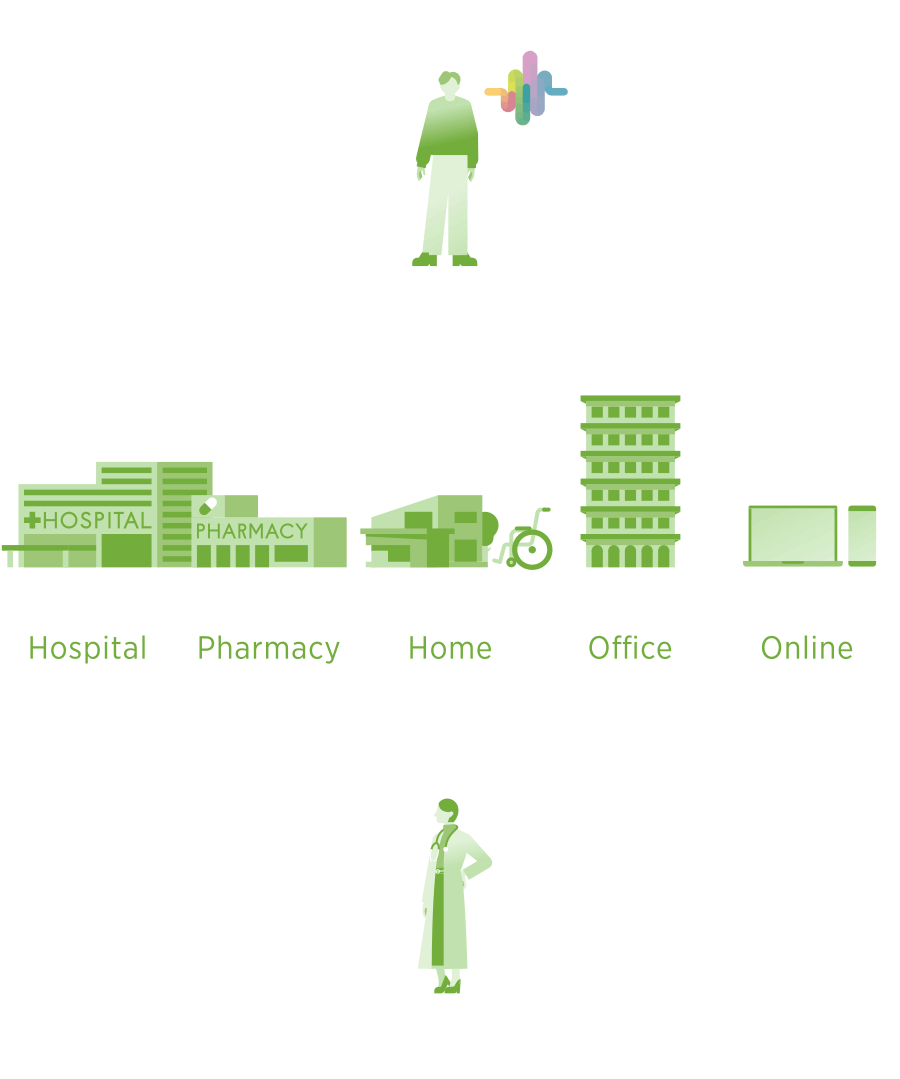VALUE
Value Proposition
MEDICAL For Medical Professionals
Your voice can tell if you...
Medical professionals grasp their patients’ conditions using all five senses to examine their gait, posture, facial expressions, touch, smell, and the “sound of voices” they utter. We have been engaged in a series of research with a focus on the “sound of voices,” which is one of the most important factors for medical professionals to grasp their patients’ conditions.

Unlocking the secret of voice
The fundamental tone of voice is produced by the vocal cords, which are vagally controlled and of which the movement cannot be changed intentionally, in combination with exhalation. The produced fundamental tone is modified by resonance in the vocal tract from the vocal cords to the lips, thereby generating the voice.
And the “sound of voice” takes on different characteristics depending on emotions such as joy, sadness, suffering, and anger, as well as on the degeneration of cranial nerves and organic changes in the heart, lung, oral cavity, pharynx, and other organs. We have created our vocal biomarker technology that captures vocal cord movement, expiratory pressure, and vocal tract modulation, which vary depending on the patient’s condition, as features, and derived algorithms to diagnose diseases and visualize pathological alterations.

Creating a new world of medical care with the “sound of voice”
We believe that our vocal biomarker technology enables non-invasive and quick diagnosis and detection of pathological alterations, contributing to reducing the burden on patients and improving work efficiency for medical professionals. The “sound of voice” can be captured in daily life, and we will soon see the day when we can predict the onset and signs of pathological alterations that are so far unexplained. PST is committed to creating a new world of medical care using our vocal biomarker technology.

Disease-specific vocal biomarkers
(For medical professionals)
Neuropsychiatric
Mood Disorders

Stress received by the brain is transmitted to the vocal cords via the recurrent (parasympathetic) nerves. The “tone of voice” formed in the resonance cavity can be adjusted voluntarily, but the vibration of the vocal folds cannot be controlled intentionally (involuntary response). Stress and depressive symptoms can be detected by measuring involuntary vocal cord tension (e.g., firmness of the voice) caused by stress or anxiety as a feature.
We are also designing features to measure normal “voice-likeness” (degree of deviation from noise) from speech waveforms. To be specific, we are developing indices to measure the clarity and liveliness of the voice by uniquely quantifying the coarseness and complexity of speech waveforms. Patients with depressive tendencies have decreased values, showing characteristics similar to noise.
- Academic Papers
- 1. How much of an impact did COVID-19 self-isolation measures have on mentalhealth? (Asian Journal of Psychiatry. Dec 2020, Impact Factor:9.5)
( https://www.ncbi.nlm.nih.gov/pmc/articles/PMC7556281/) - 2. Evaluation of emotional arousal level and depression severity using voice-derivedsound pressure change acceleration. (Scientific Reports 2021, Impact Factor:4.6)
( https://www.nature.com/articles/s41598-021-92982-7) - 3. Performance Evaluation of a Voice-Based Depression Assessment SystemConsidering the Number and Type of Input Utterances. (Sensors 2022, Impact Factor:3.9)
( https://www.mdpi.com/1424-8220/22/1/67) - 4. Evaluation of the severity of major depression using a voice index for emotionalarousal. (Sensors 2020, Impact Factor:3.9)
( https://www.ncbi.nlm.nih.gov/pmc/articles/PMC7570922/) - 5. Effectiveness of a Voice-Based Mental Health Evaluation System for Mobile Devices:Prospective Study. (JMIR Formative Research 2020, Impact Factor:2.2)
( https://pubmed.ncbi.nlm.nih.gov/32554367/) - 6. Estimating Depressive Symptom Class from Voice. (International Journal of Environmental Research and Public Health, 2021 ImpactFactor:4.614)
( https://www.ncbi.nlm.nih.gov/pmc/articles/PMC10002315/)
- Conference Presentations
- ・Study on Indicators for Depression in the Elderly Using Voice and Attribute Information, (Information and Communication Technologies for Ageing Well and e-Health, 14 June 2018, ICT4AWE 2017 Conference paper)
(https://link.springer.com/chapter/10.1007/978-3-319-93644-4_7)
Neuropsychiatric
MCI (Mild Cognitive Impairment) /
Dementia (Alzheimer-type Dementia
- AD and Dementia with Lewy Bodies- DLB)

To utter a “normal voice,” the left and right vocal cords must be in contact with each other without a gap. As cognitive function declines, the vocal muscles are not properly controlled via the recurrent nerve, making it difficult to keep the vocal cords steadily in contact with each other. As a result, you hear a fluctuation of the fundamental tone and a breathy voice (breathiness) (breathiness appears in the feature measured by sustained vowels). In addition, the strength and rhythm of vocalization become unstable in association with decreased motor function (stability appears in the feature measured by a specific phrase uttered repeatedly).
- Academic Papers
- 1. Novel Screening Tool Using Non-linguistic Voice Features Derived from Simple Phrases to Detect Mild Cognitive Impairment and Dementia. (JAR Life, 23 Aug 2023)( https://www.ncbi.nlm.nih.gov/pmc/articles/pmid/37637273/)
- 2. Discrimination of mild cognitive impairment based on involuntary changes causedin voice elements. (Frontiers in Neurology, 21 June 2023, Impact Factor:3.4)( https://www.frontiersin.org/articles/10.3389/fneur.2023.1197840/full)
- Conference Presentations
- 1. Pilot study to assess cognitive decline based on vocal analysis. (IUPESM WorldCongress on Medical Physics and Biomedical Engineering 2022)
- 2. Study of auto-detecting mild cognitive impairment using pauses in speechesduring letter fluency tasks. (IUPESM World Congress on Medical Physics andBiomedical Engineering 2022)
Cardiovascular
Cardiac failure

The pumping function of the heart is decreased, resulting in an inability to balance intravascular volume in the body. As a result, pleural effusion accumulates in pleural cavity, and lungs get congested , making it difficult to adequately inhale and exhale. The expiratory flow volume and rate are decreased when pleural effusion accumulates in pleural cavity, and lungs get congested. The expiratory flow from the lungs is the power source of vocalization.
Without sufficient expiratory flow, the vocal cords vibrate irregularly and the noise component increases, resulting in a coarse voice (rough voice). The more apparent changes include decreased duration and volume of the voice.
- Academic Papers/Proceedings
- ・Clinical utility of machine learning-derived vocal-biomarker inthe management of heart failure ‒ GOKAN-HF ‒. (European Heart Journal ‒ Digital Health, 投稿中 )
- Conference Presentations
- ・Clinical Utility of Machine Learning-Derived Vocal-Biomarker in the Management of Heart Failure. (the American Heart Association's 2022 Scientific Session)









